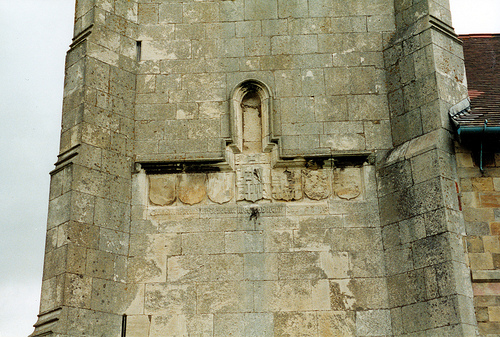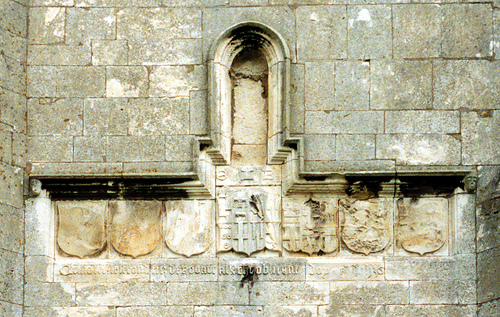Medieval History

The west tower of Aughton church on the banks of the river Derwent in the East Riding of Yorkshire, has an armorial panel on its southern face that incorporates a rather curious inscription in Old French. 'Christofer le second filz de Robert Ask chr oblier ne doy, Ao Di 1536'. Samuel Pegge the antiquarian, writing for the Gentleman's Magazine in 1754, under his pseudonym 'Mr Gemsege', was the first to try and interpret this inscription and he came to the conclusion that it could be translated in two ways. Either as: 'I Christopher, the second son of Sir Robert Aske, ought not to forget the year of Our Lord 1536', or 'I ought not to forget, Christopher, the second son of Robert Aske. The year of Our Lord 1536'.

Generally speaking Pegge's former interpretation of the text, is usually accepted these days as correct, that Aske was using this inscription to highlight this year for particular remembrance. For Aske's motive for making this permanent statement in stone, we have to examine to the events of that year. The year 1536 was the year that Henrician Reformation really began to hot up, it was the year that Henry VIII began to dissolve the Monasteries and rumours began to circulate of the possible confiscation, in turn, of parochial assets. In October 1536 in response to the first dissolutions and this active rumour mill, the commons of Lincolnshire and then of Yorkshire rose in rebellion. The second rebellion in Yorkshire became known as the Pilgrimage of Grace. The commons marched to York and then to Doncaster under the banner of the five wounds of Christ, led by a London Barrister called Robert Aske. Robert Aske was the third son of Sir Robert Aske of Aughton and brother of Christopher who put up the inscription. After Robert Aske bargained with the Duke of Norfolk at Doncaster, who offered a general pardon from the King, the 40,000 strong host under Aske's command were dismissed and the 'Pilgrimage' ended. However, fresh outbreaks of minor rebellion broke out further north in February 1537 and in response to this Robert Aske was executed in York in July 1537. Robert Aske's elder brother Christopher had good cause to put up an inscription on the tower of Aughton church calling to mind the year 1536.
- Schools Event: The Early Medieval World
The Department of Anglo-Saxon, Norse & Celtic will be invading York on 20th March, for a one-day event aimed at Year 11 and 12 students and their teachers. The conference, for which there is no charge (lunch and refreshments provided too!),...
- 34th Annual Harvard Celtic Colloquium
10, 11 and 12 October 2014 The Thompson Room (Room 110) Barker Center, 12 Quincy Street ~ Call For Papers The organizers of the 34th Annual Harvard Celtic Colloquium acknowledge with thanks the support of The Provostial Funds Committee for the Arts and...
- Upcoming Assc Event
The Anglo Saxon Studies Colloquiumannouncesa lecture and seminar *Joshua Davies* *(KIng's College, The University of London)* ??Visions...
- Author Interviews Coming To Ancient & Medieval Mayhem Blog In June
ROBYN YOUNGInterview with Author, Robyn Young. In early June to kick off the Ancient & Medieval Historical Fiction Group's Medieval Group Read of Insurrection. ...
- Beware The Ides Of March
The Norman chancel arch at Glympton in Oxfordshire has the following interesting and tantalising inscription carved on its jamb: 'Dedicatio hujus templi Idus Martii' i.e. 'this temple was dedicated on the Ides (15th) of...
Medieval History
'Christopher ought not to forget'

The west tower of Aughton church on the banks of the river Derwent in the East Riding of Yorkshire, has an armorial panel on its southern face that incorporates a rather curious inscription in Old French. 'Christofer le second filz de Robert Ask chr oblier ne doy, Ao Di 1536'. Samuel Pegge the antiquarian, writing for the Gentleman's Magazine in 1754, under his pseudonym 'Mr Gemsege', was the first to try and interpret this inscription and he came to the conclusion that it could be translated in two ways. Either as: 'I Christopher, the second son of Sir Robert Aske, ought not to forget the year of Our Lord 1536', or 'I ought not to forget, Christopher, the second son of Robert Aske. The year of Our Lord 1536'.

Generally speaking Pegge's former interpretation of the text, is usually accepted these days as correct, that Aske was using this inscription to highlight this year for particular remembrance. For Aske's motive for making this permanent statement in stone, we have to examine to the events of that year. The year 1536 was the year that Henrician Reformation really began to hot up, it was the year that Henry VIII began to dissolve the Monasteries and rumours began to circulate of the possible confiscation, in turn, of parochial assets. In October 1536 in response to the first dissolutions and this active rumour mill, the commons of Lincolnshire and then of Yorkshire rose in rebellion. The second rebellion in Yorkshire became known as the Pilgrimage of Grace. The commons marched to York and then to Doncaster under the banner of the five wounds of Christ, led by a London Barrister called Robert Aske. Robert Aske was the third son of Sir Robert Aske of Aughton and brother of Christopher who put up the inscription. After Robert Aske bargained with the Duke of Norfolk at Doncaster, who offered a general pardon from the King, the 40,000 strong host under Aske's command were dismissed and the 'Pilgrimage' ended. However, fresh outbreaks of minor rebellion broke out further north in February 1537 and in response to this Robert Aske was executed in York in July 1537. Robert Aske's elder brother Christopher had good cause to put up an inscription on the tower of Aughton church calling to mind the year 1536.
- Schools Event: The Early Medieval World
The Department of Anglo-Saxon, Norse & Celtic will be invading York on 20th March, for a one-day event aimed at Year 11 and 12 students and their teachers. The conference, for which there is no charge (lunch and refreshments provided too!),...
- 34th Annual Harvard Celtic Colloquium
10, 11 and 12 October 2014 The Thompson Room (Room 110) Barker Center, 12 Quincy Street ~ Call For Papers The organizers of the 34th Annual Harvard Celtic Colloquium acknowledge with thanks the support of The Provostial Funds Committee for the Arts and...
- Upcoming Assc Event
The Anglo Saxon Studies Colloquiumannouncesa lecture and seminar *Joshua Davies* *(KIng's College, The University of London)* ??Visions...
- Author Interviews Coming To Ancient & Medieval Mayhem Blog In June
ROBYN YOUNGInterview with Author, Robyn Young. In early June to kick off the Ancient & Medieval Historical Fiction Group's Medieval Group Read of Insurrection. ...
- Beware The Ides Of March
The Norman chancel arch at Glympton in Oxfordshire has the following interesting and tantalising inscription carved on its jamb: 'Dedicatio hujus templi Idus Martii' i.e. 'this temple was dedicated on the Ides (15th) of...
